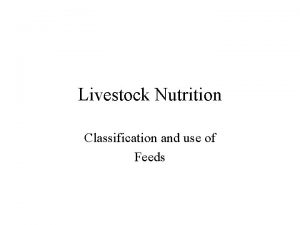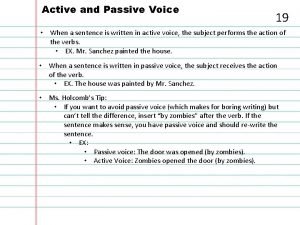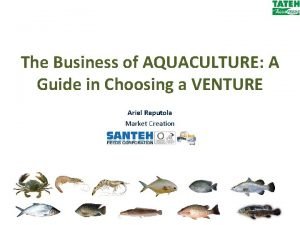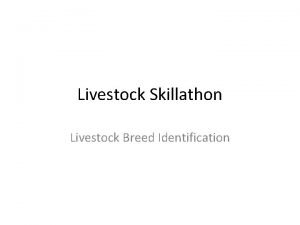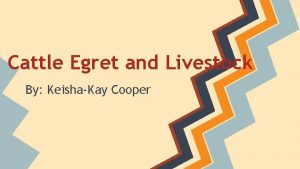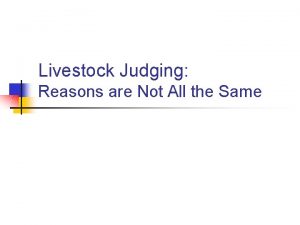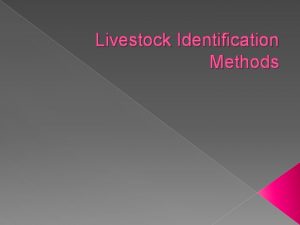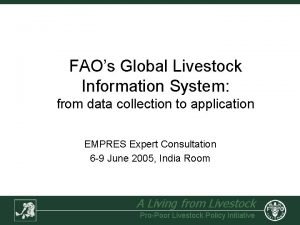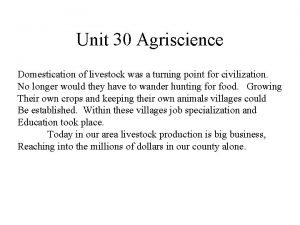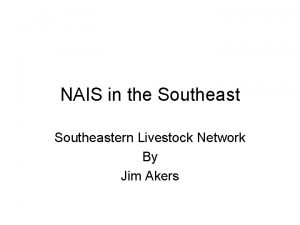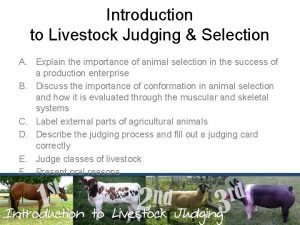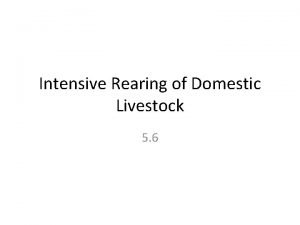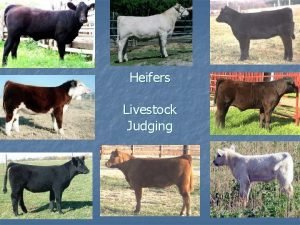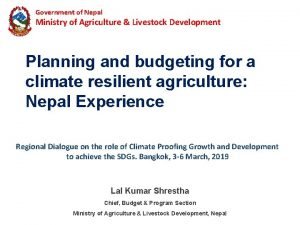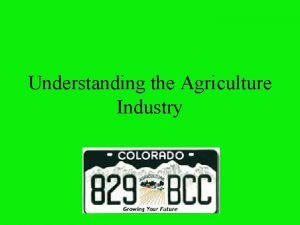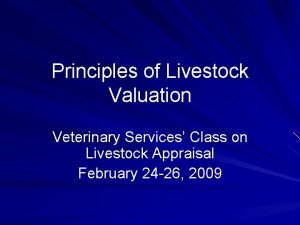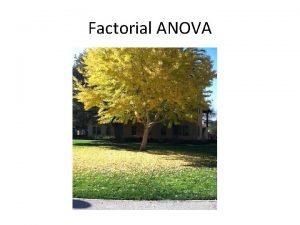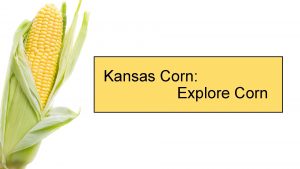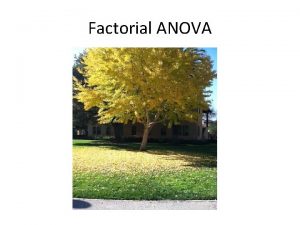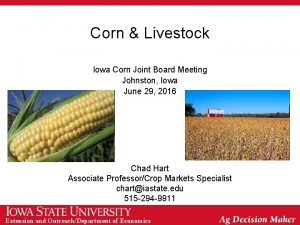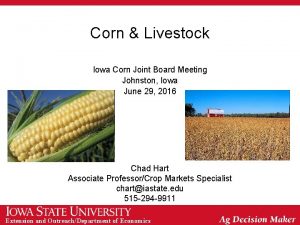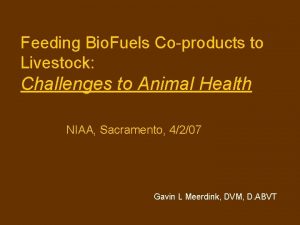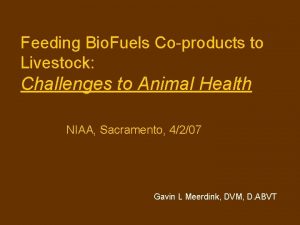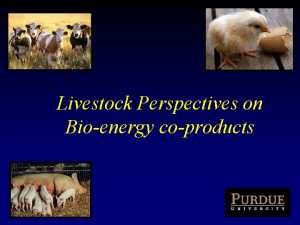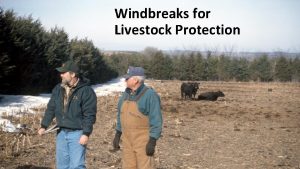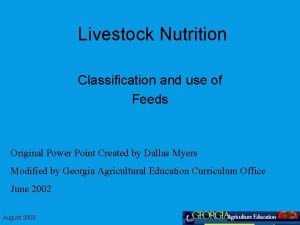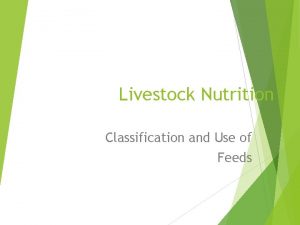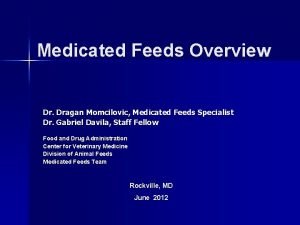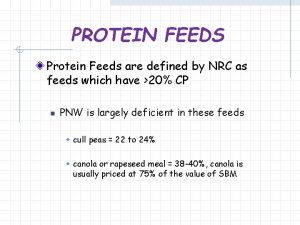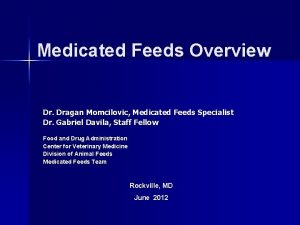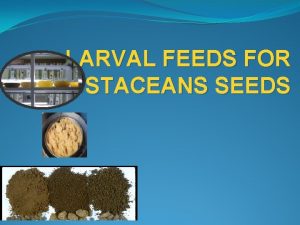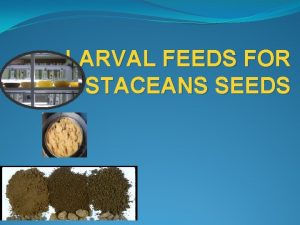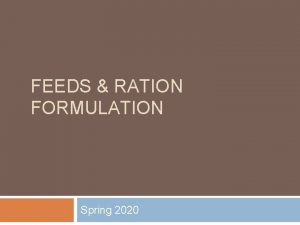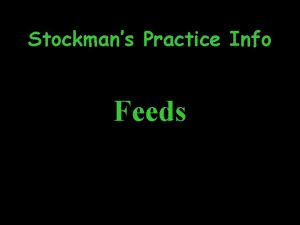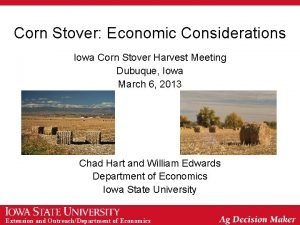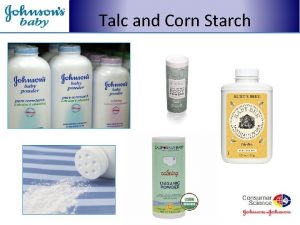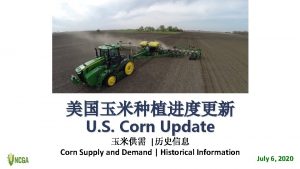Understanding Corn Processing Coproducts Use in Livestock Feeds

























- Slides: 25

Understanding Corn Processing Co-products Use in Livestock Feeds John D. Lawrence, Iowa State University Darrell Mark, University of Nebraska

Outline • Trend in corn processing • Implications for corn prices • Cellulosic ethanol potential • Types of corn processing • Coproducts and nutritional values • Factors to consider before feeding • Summary



US Ethanol Production June 2006 Status • • Plants Operational Construction Announced Potential total 102 32 127 261 B/Gal 4. 75 3. 03 8. 21 15. 99 • Potential corn use: 5. 3 -5. 9 B/bu • Some estimates are higher Source: National Corn Growers Association

Implications for Corn Prices • Increased demand for corn is expected to: – Increase corn prices – Increase corn acres • Long run price impact will depend on – Price of oil and energy value of ethanol – Timing and cost efficiency of biomass to ethanol – Inclusion rates of co-product feeds in livestock diets • Short term price impact could be significant – Weather induced shortages – Mismatch of acres and ethanol plants

Biomass Ethanol • Interest in low nitrogen using perennials • Switchgrass, wood, municipal waste and exotic plants like kanaf, crotalaria, etc. • Also can use corn stover and coproducts like distillers grains and corn gluten feed • May reduce demand acreage of corn • Technology “ 5 -years away”, but plant announced to operate in 2009

Two Types of Processing • Wet mills – Very large and costly to construct – Multiple products • High Fructose Sweetener, corn oil, ethanol • Corn gluten meal, corn gluten feed and others • Dry mills – Generally smaller and less costly – Two products • Ethanol • Distillers grains and solubles

Wet Milling-Corn Gluten Feed STEEP GRIND STEEP CORN WASH WATER SEPARATION STARCH, SWEETNER, ALCOHOL GLUTEN MEAL CORN OIL CORN BRAN SEM, screenings, dist solubles WET CORN GLUTEN FEED DRY CORN GLUTEN FEED

Products of Wet Corn Milling • One bushel of corn yields Product Pounds – Starch 31. 5 Further processed into 33# of sweetener or 2. 5 gallons of ethanol. – Gluten feed 13. 5 – Gluten meal 2. 5 – Corn meal 1. 6

Corn Gluten Feed (CGF) • Corn bran + steep • Can be wet or dry • Moderate crude protein, CP = 16 -23% – 80% of CP is DIP (ruminally degradable) • Low fat, moderate fiber, TDN = 80 • 101 -115% of energy value of dry-rolled corn • Product variation is significant within and across plants due to amount of steep added back to the corn bran • Looks like oatmeal

Dry Milling-Distillers Grains + Solubles CORN GRIND, WET, COOK FERMENTATION YEAST, ENZYMES STILL ALCOHOL & CO 2 STILLAGE DISTILLERS GRAINS WDG, DDG DISTILLERS SOLUBLES WDGS DDGS

Products of Dry Corn Milling • One bushel of corn yields – Ethanol 2. 7 gallons – Distillers grains & solubles 17 -18 pounds • DGS are one third the weight of the corn and all but the starch is concentrated into this one-third • Sulfur is concentrated and may have been used in the fermenting process • Mycotoxins, if they existed in the corn are also concentrated 3: 1

Distillers Grains + Solubles (DGS) • About 65% Distillers Grains & 35% Solubles (DM basis) • May be wet or dried • Higher crude protein, CP = 30% – 65% UIP (undegraded, “bypass”, protein) • High fat (11%), low fiber, TDN = 70 -110 • Concentrates nutrients 3 -fold from corn – 0. 8% P, 0. 35 -1. 0% Sulfur (variable) • WDGS looks like mashed potatoes

New “Combination” Products • Modified wet DGS are available – (35 -65% DM) • Hybrid wet & dry plant combining corn bran and distillers solubles bran cake – Example: Dakota Bran Cake

Nutrient Composition of Selected Corn Milling Co-Products

Factors to Consider Before Feeding Coproducts • Nutrients only have value if needed – High protein or energy may not be needed • Abrupt changes may put animals off feed • Darker brown color indicates it may have been overheated, ties up lysine • Upper limits on inclusion rates for some livestock types and weights • Excess sulfur possible at high levels and high water levels of sulfur • Phosphorous concentration in manure

Factors to Consider Before Feeding Coproducts • Storage issues, dry product – Additional storage bin – Problems with flow ability in bulk bins • Storage issues, wet product – Wet product will spoil in 7 -14 days depending on temperature and storage method – Wet product can freeze – Requires good bunk management

Challenges • DGS is most available in late summer – Seasonally cheapest then too – Seasonally fewest cattle on feed then too • Storing wet DGS product – Material exposed to air spoils in 7 -14 days depending on temperature – Has low p. H and does not ensile but will keep in air-tight storage for long periods – Spoilage loss stored in silage bags (Walker et al) • 20% loss opened and fed day 78 -112 post-sealing • 28% loss opened and fed day 190 -257 post sealing

When WDGS Price Is Lowest

Storing WDGS • Storing wet DGS product – Often delivered in truck load lots – Can store wet DGS in bunker, silage bag or in pile covered with plastic to protect from air – Should mix with tub-ground forage and stored in bunker or bag – Have to have the “mix” right…


Minimum Levels of Roughage To Mix in WDGS For Storage Grass hay Wheat straw Alfalfa hay DDGS ADMCGF a 300 PSI. Bagginga Bunker 15% 12. 5 22. 5 50 60 30 -40 25 -32 45 -55? ----Source: Erickson & Klopfenstein

Summary • Increased corn demand prices – Implications for crop acres and land prices – Higher feed cost pressures feeder animal price – Biomass may reduce need for corn, but also reduce coproduct supply • Often coproducts will reduce ration cost • Limits on maximum inclusion rates in diets • Technical issues with storages and handling

Resources • http: //beef. unl. edu • www. iowabeefcenter. org • http: //www. ddgs. umn. edu/
 Classification of feeds
Classification of feeds Biting the hand that feeds you figurative language
Biting the hand that feeds you figurative language Can i have one of your chips figurative language
Can i have one of your chips figurative language Active to passive voice
Active to passive voice Dinner is on the house figurative language
Dinner is on the house figurative language Programming rss feeds
Programming rss feeds She has a skeleton in her closet figurative language
She has a skeleton in her closet figurative language Tmg feeds
Tmg feeds Mimaropa region
Mimaropa region Livestock breed identification sheep
Livestock breed identification sheep Cattle egrets and livestock
Cattle egrets and livestock Livestock judging oral reasons
Livestock judging oral reasons Livestock judging reasons
Livestock judging reasons Livestock risk management brokers near me
Livestock risk management brokers near me Animal kingdom taxonomy chart
Animal kingdom taxonomy chart Livestock identification methods
Livestock identification methods Livestock information system
Livestock information system Livestock breed identification swine - vocabulary
Livestock breed identification swine - vocabulary Parasites of livestock - vocabulary
Parasites of livestock - vocabulary Livestock network
Livestock network Livestock judging card
Livestock judging card Domestic livestock
Domestic livestock Livestock judging basics
Livestock judging basics Ministry of agriculture and livestock development nepal
Ministry of agriculture and livestock development nepal Colorado agriculture facts
Colorado agriculture facts Livestock valuation methods
Livestock valuation methods
